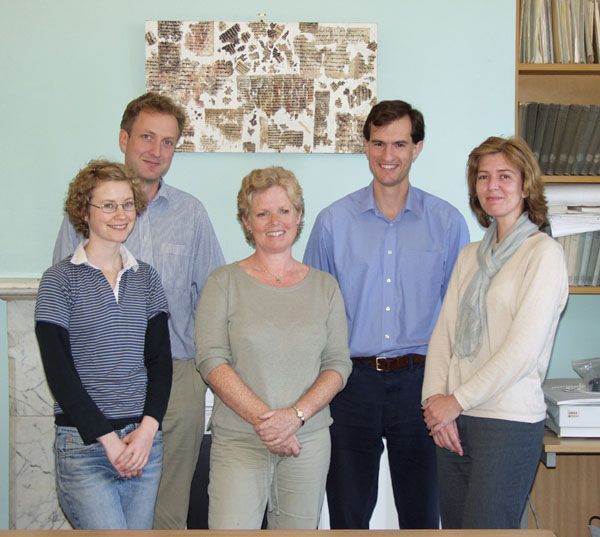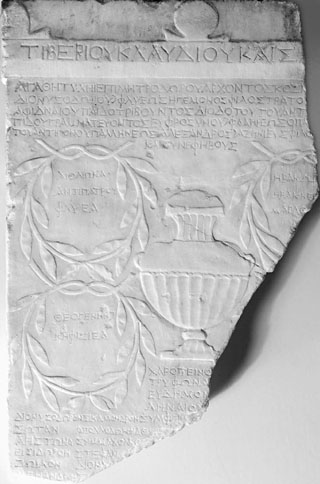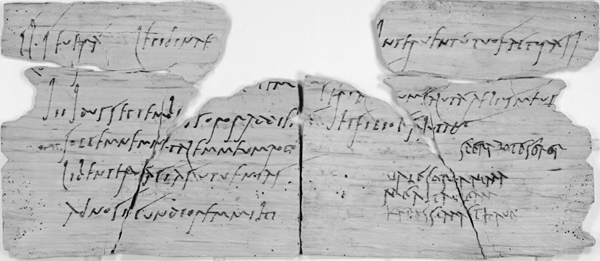
| CSAD Newsletter 9, Winter 2002 |
The beginning of the academic year 2001/2 sees an exciting new phase in the development of the Centre for the Study of Ancient Documents with the launching of a programme of related projects entitled Script, Image and the Culture Of Writing in the Ancient World funded for a three-year period from 1 October, 2001 by the Andrew W. Mellon Foundation as part of its Scholarly Communication initiative.
The opportunity provided by the funding from the Mellon Foundation to make a series of new appointments has brought an infusion of fresh ideas and energy into the Centre. New staff members are Maggy Sasanow, who has become the Centre's Administrator, Jessica Ratcliff, who takes responsibility for the Centre's Internet presence as IT Officer, and two full-time research assistants, Dr John Pearce and Dr Peter Haarer. Dr Pearce was previously employed as Research Assistant to the AHRB-funded Vindolanda Ink Tablets project; this post is now held by Dr Frédérique Landuyt.

Project Staff (left to right): Jessica Ratcliff (IT Officer), John Pearce (Research Assistant), Maggy Sasanow (Administrator), Peter Haarer, Frédérique Landuyt (Research Assistants)
The aim of the Script, Image and the Culture of Writing in the Ancient World programme is to create a hub of knowledge and data accessible through the Internet that will enable researchers worldwide from all backgrounds, young and old, scholastic and intellectually curious, better to understand writing in the Ancient World as a technology in its archaeological and cultural context. The programme consists of six separate elements, two epigraphical, two papyrological and two Romano-British. Both the individual projects and the overall programme complement projects already underway at the Centre.
The principal epigraphic project is concerned with the earliest alphabetic documents written in Greek. The development of the Greek alphabet is one of the more remarkable and formative episodes in the history of the ancient Mediterranean World. The CSAD's research collection includes the unpublished papers and photographs of the late L.H. Jeffery, whose Local Scripts of Archaic Greece has become the standard treatment of early Greek writing. This is an unique and immensely valuable resource. Jeffery assembled individual dossiers for all available examples of Greek writing from the archaic period (c. 800-500 BC). The dossiers contain bibliography, commentary, physical descriptions and hundreds of annotated line drawings, together with an extensive collection of medium-format negatives taken by Jeffery herself which fully document the remarkable variety of early Greek forms of writing. Many of these photographs are of objects which are now inaccessible or have deteriorated since they were photographed. We plan to catalogue and digitise Jeffery's drawings and photographs (which also record the important excavations of Archaic Greek sites at Bayrakli (Old Smyrna) and Emporio on Chios), together with associated material in her papers, to provide a comprehensive and detailed on-line resource for the study of early Greek writing.
A second epigraphical project is a programme of photographing the Ashmolean's important collection of Greek and Latin inscriptions using a high resolution digital studio camera. Inscriptions are studied by historians primarily as written texts and only secondarily as physical objects, although the physical character of the inscription frequently has an important bearing on its interpretation. The Ashmolean inscriptions will be photographed from a range of angles to allow three-dimensional virtual reconstructions to be created so that information about the physical characteristics of a representative sample of inscriptions can be made directly available to historians and students.

Ashmolean inventory C2.56 (IG ii2 1973): Athenian ephebic inscription dating to the reign of the Emperor Claudius - one of the inscriptions to be photographed as part of the Ashmolean inscriptions project
In the 1970s and 1980s an International Photographic Mission initiated and sponsored by the Association Internationale de Papyrologues and UNESCO made slides and photographs of the collection of Greek papyri held in the Cairo Museum, which includes important material related to texts in other archives and collections, notably the Karanis papyri at the University of Michigan, the Zenon archive, and the 6th century material from Aphrodito and elsewhere. The photographic archive consists of more than 5000 slides and large format negatives. As a third element in the programme we plan to catalogue and digitise the photographs in the Cairo Archive so that they can be made available on-line. The catalogue will contain full cross-references to editions and publication details and will link to the on-line transcriptions available in the Duke Databank of Documentary Papyri. The catalogue format will be based on the record structure developed for the Advanced Papyrological Information System (APIS), and it is intended that the completed database will eventually be integrated into APIS.
As a fourth element of the Script, Image and the Culture of Writing in the Ancient World programme we propose to compile a gazetteer of the source, content and location of papyrus collections held in Britain. This project follows a recent initiative by Dr. Willy Clarysse at Leuven to survey a small number of collections as a first step toward the creation of a worldwide gazetteer of papyrus collections. This pilot version included only one small group of British collections (in Cambridge). No other such gazetteers are publicly available.
The British gazetteer will use the format established by Dr. Clarysse, which can be seen on the Leuven pilot project's homepage (http://lhpc.arts.kuleuven.ac.be), and it is hoped that its compilation will encourage the cataloguing of other collections. The completion of a worldwide gazetteer and the compilation and publication of information which has until now been largely inaccessible should facilitate the process of "virtual reassembly" of fragmented archives. Reconstruction of the process of acquisition of papyri from Egypt by excavation and through the antiquities market is likely to lead to real advances in our knowledge of the archaeology and documentation of Egypt and enable us to make significant connections between groups of texts which were dispersed during the flurry of acquisition of papyri in the late nineteenth and early twentieth centuries.
The fifth element of the programme is the creation of a website consisting of texts and images of the Vindolanda ink writing-tablets. This corpus of over 400 Latin texts is the most important collection of early Latin documents from the Western Empire, making an unique contribution to our knowledge of early Latin writing and writing-materials, of vulgar Latin in the middle empire, and of the military, social and economic structure which underpinned the Roman occupation of the frontier in Britain.

TV II 291: Letter from Claudia Severa to Sulpicia Lepidina, wife of the prefect Cerialis, inviting Lepidina to her birthday celebration; this text from the Vindolanda archive, with a closing greeting in Severa's own hand, preserves one of the earliest known examples of writing in Latin by a woman
The compilation of an archive of high-resolution digital images of the tablets, in collaboration with the British Museum, which owns the tablets, is now almost complete and has already led to significant advances in the reading of the tablets. These images will be made available as part of an electronic database of texts and images, incorporating links to supporting palaeographical, linguistic, archaeological and historical material. We aim to make the database accessible at a wide variety of levels - from research scholars to 7-9 year olds for whom the Latin teaching programme 'Minimus' has been developed using the Vindolanda texts as its core. Other elements in the site will include full supporting commentaries on the individual texts drawn from the editions by Alan Bowman and David Thomas in Tabulae Vindolandenses I and II; an illustrated guide to the palaeography and the characteristics of early Latin writing; examples illustrating the contribution to knowledge of spoken and written vulgar Latin in Roman Britain; evidence for the physical context of the deposit at the site of Vindolanda in relation to the topography and buildings of the early forts; archaeological evidence for the artefacts, places, military institutions and other items mentioned in the texts; 'snapshots' of daily life in the commanding officer's residence at Vindolanda which the tablets illuminate in detail - as in the example illustrated above, TV II 291, Claudia Severa's birthday invitation to Sulpicia Lepidina, the wife of the prefect Cerialis. All this will be supported by references to relevant material from other archaeological and internet sites.
Finally, we plan to develop a database and website for the texts and images of the lead curse-tablets from the shrines at Uley in Gloucestershire. Although curse tablets are widely known in the Greek and Roman world, there are few sites for which the archaeological context is known and documented in such accurate detail as at Uley. Using the Vindolanda database as a model we hope to be able to place the Uley tablets in their archaeological and material context and, in doing so, offer an impression of the religious and literary culture within which they were produced. The project should provide an impetus to the incorporation of other collections such as the very important and much larger one from the Temple of Sulis Minerva at Bath (where the evidence for the archaeological context is comparable).
This is an exciting time for the Centre. The Vindolanda website has been adopted as a project by the University's Academic Computing Development Team (ACDT) for 2001/2 and a target date of October 2002 for the site to be published has been set. Work on the Early Greek Writing project is also well under way. An introductory survey of the range of material in the Jeffery archive is available immediately from the Centre's server (http://www.csad.ox.ac.uk/Mellon/LSAG). In Trinity Term work will begin on digitising the colour slides of the Zenon papyri in the Cairo Photographic Library. When we report back in the next Newsletter we should have substantial progress to communicate.
Charles Crowther
Maggy Sasanow
Home | What's New | Events | Images | Links
| Created on |